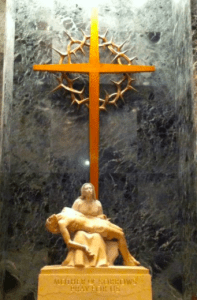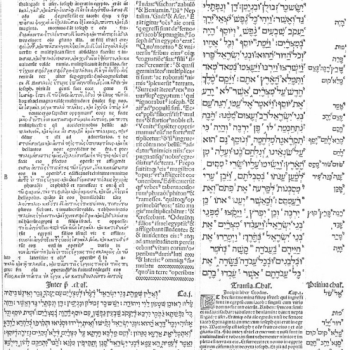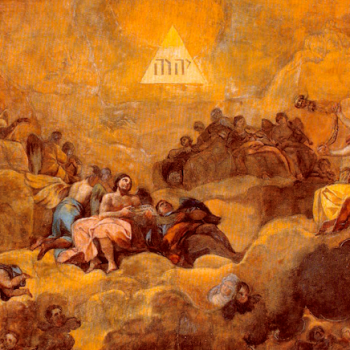Go here for a general introduction to the rosary, and here for meditations on the Joyful and Luminous Mysteries.
The Mysteries
These mysteries are taken from the Passion narrative, which is of course broadly familiar to Christians, and indeed to many non-Christians. The selection of events emphasizes his physical sufferings, as distinct from “social” aspects of the Passion (like the unjust trial before the Sanhedrin or St. Peter’s treachery).
1. The Agony of Christ in Gethsemane
This covers Christ’s prayer to the Father to be spared, followed by Judas’ betrayal and the arrest.
2. The Scourging of Christ at the Pillar
This covers Christ being whipped at the command of Pilate, before the sentence of execution.
3. The Crowning of Christ with Thorns
This covers the mockery of the soldiers before the enactment of the crucifixion.
4. The Bearing by Christ of the Cross
This covers Christ carrying his cross to Golgotha
5. The Crucifixion of Christ and His Death
Another fairly self-explanatory mystery.

Meditations for the Sorrowful Mysteries
As one of the principal events of the redemption, these mysteries are particularly well-suited to allegorical meditations. My favorite texts for this purpose come from the Song of Solomon. The Passion was supremely an act of love, a ratification of the marriage between Christ and the Church; various verses from the Song of Solomon can therefore be applied with the imagery of the Passion in mind. (One detail I wish we Latins would borrow from the East is the use of crowns in the nuptial liturgy.)
1. The Agony. Song 3.1, By night I sought him whom my soul loveth: I sought him, but I found him not. Compare this with both the unanswered prayer in Gethsemane, and the confusion over who in the crowd of disciples was Jesus in the beginning of John 18.
2. The Scourging. Song 5.10, My beloved is white and ruddy, the chiefest among ten thousand. The ruddiness, or redness, here can be thought of as denoting the blood running from the wounds.
3. The Crowning. Song 3.11, Behold the king with the crown wherewith his mother crowned him in the day of his espousals. Obviously the Theotokos was not the one who literally placed the crown of thorns on Christ’s head, but, in addition to the bridal imagery the text brings in, this serves as a reminder of her presence and faithfulness at the crucifixion.
4. The Bearing. Song 3.6, Who is this that cometh out of the wilderness like pillars of smoke, perfumed with myrrh and frankincense? The mention of myrrh and frankincense in particular is multi-sided, as these aromatics were used as personal perfumes, as burial spices (both limiting decay and making it more tolerable), and as ingredients in sacred incense.
5. The Crucifixion. Song 5.2, I sleep, but my heart waketh. Sleep is a frequent symbol or euphemism for death in Scripture; the reference to waking presages the Resurrection, as well as suggesting the harrowing of hell.












